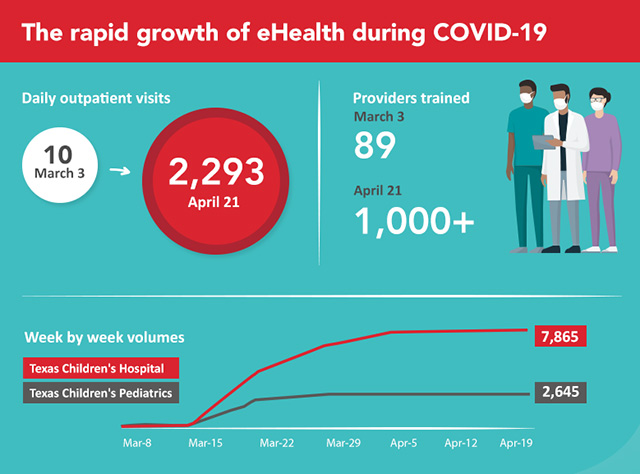As the COVID-19 pandemic continues to dominate the news and impact our normal way of life, there is one thing that has not changed – our commitment to ensuring our patients and families have convenient access to the care they need, when they need it, while also continuing to protect their health and safety.
As we begin to adapt to this new normal, more in-person visits are being converted to video or phone appointments. Texas Children’s e-Health team, in collaboration with multiple departments across the system, has rapidly expanded and enhanced these e-Health services to make it easier and more convenient for patients to connect with a Texas Children’s provider without leaving their home.
In less than three months, the organization has seen a rapid growth in e-Health visits across the system. On March 2, Texas Children’s completed 39 video and telephone appointments. As of May 8, our providers had completed 72,285 telephone and video visits across Texas Children’s Hospital, Texas Children’s Pediatrics, Texas Children’s Urgent Care, Texas Children’s Health Plan and Texas Children’s® Anywhere Care. Along with this impressive milestone, over 1,000 providers have been trained to provide care through video visits to their patients across the system.
The Health Plan’s e-Health platform, Texas Children’s® Anywhere Care, which has been a major focus in the organization’s e-Health efforts, has seen an uptick in patient visits. Since launching the platform last summer, over 1,520 video appointments have been completed. A total of 750 e-Health visits were completed from March 1 to May 5 of this year.
“Our recent successes are attributed to the collaborative efforts that went into building the infrastructure that has enabled us to expand our e-Health capabilities more broadly across the system,” said Laura Laux Higgins, director of strategic projects in Information Services and member of the e-Health Executive Steering Team. “Not only did we investigate the technology solutions and invest in them, we had a team of e-Health experts in place across information security, EPIC, MyChart, billing, compliance, legal, credentialing, risk, and administrative and physician leadership who were able to help us move forward quickly because of the work they had done over the past year.”
With the demand for e-Health services on the rise due to COVID-19, Texas Children’s Heart Center, like many other subspecialties across the system, are leveraging the mutual benefits of e-Health services.
Shortly after the COVID-19 pandemic set in and local, state and federal governments asked non-essential businesses to close and residents to stay home, the Heart Center worked swiftly with physicians and staff to engage e-Health services for new and existing patients 6 months old and older who did not need to be seen in person.
Within about a week, the Heart Center was booking about half of its appointments at the Texas Children’s Medical Center Campus via video or phone. Although that number has decreased since Gov. Greg Abbott has started to reopen parts of the state, the Heart Center is still using e-Health services and is dedicated to the virtual patient care model for the foreseeable future.
“Our will to continue to work hard and keep our patients, families and staff safe has never been stronger,” said Chief of Pediatric Cardiology Dr. Daniel Penny. “e-Health is a way we can continue to serve our patients without putting them at unnecessary risk.”
All potential e-Health appointments at the Heart Center are reviewed by a pediatric cardiologist or advanced practice provider to determine whether it is clinically appropriate for a child’s appointment to be completed using one of these modes of virtual visit. If the cardiologist considers that a child’s appointment can be completed in this way, the clinic staff will contact the child’s family to provide more details and guide them through the new system.
Dr. Jeffrey Kim, director of the Arrhythmia and Pacing (Electrophysiology) Service at Texas Children’s Hospital, said his patients are good candidates for e-Health visits because they typically don’t need surgical intervention. For about a month during the pandemic, Kim said almost all arrhythmia and pacing patients were utilizing e-Health visits. Now, about half are using the service.
“Patients are very appreciative of the virtual visits,” Kim said, adding he conducted an appointment with a patient while they were standing in the middle of a field on their ranch. “They are thankful they don’t have to come in and expose themselves if they don’t have to.”
In addition to safety, Kim said e-Health services can be used to treat people in areas where there are limited pediatric cardiology services. Patients in these areas might not be able to drive into places like Houston for an appointment forgoing care altogether or seeking it in less-than-ideal places. e-Health would bring the visit to them, allowing our experts to reach more children and families.
“e-Health has a lot of benefits and possibilities,” Kim said. “I’m excited to see how it develops.”


